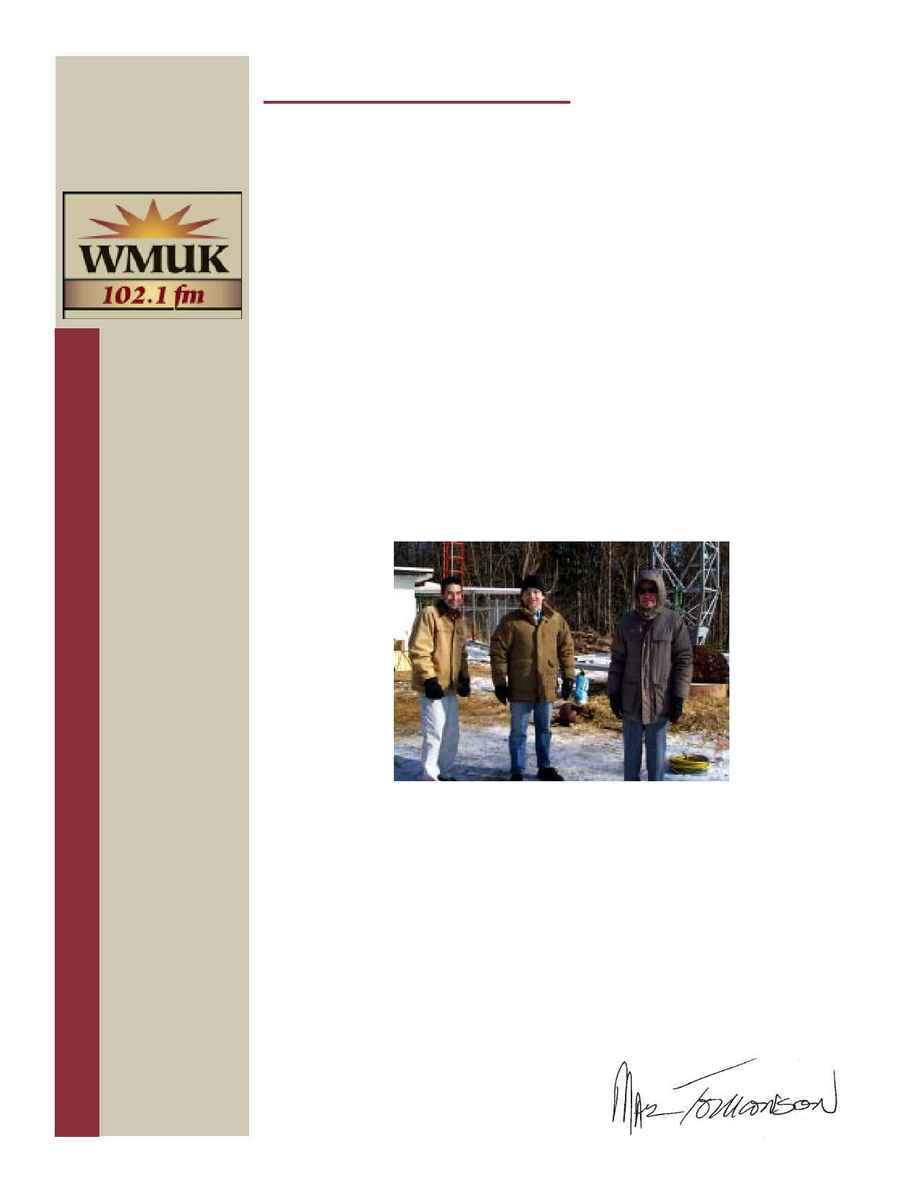
Making (Radio) Waves
What Does the WMUK Capital Campaign
Mean to You? Does it mean better sound?
Does it mean more and higher quality
programming? Does it mean WMUK is less
likely to be off the air when there are high winds
and ice storms?
It means all of the above.
The Electronic Pipeline: WMUK transmits
a 50,000 watt signal from an antenna supported
by our new 350 foot tower located on one of
the highest points in Plainwell. The power
output is regulated by the terms of our license
from the Federal Communications Commission
(FCC). That's a start... but how does the
sound get to you, and in what form?
About half of WMUK's programming is
created in-house; the rest is purchased from
NPR, BBC, and PRI. Network programs are
transmitted by
satellite and come
into the station
through new
fiber optic cables
from our campus
downlink. A
large audio
server gathers the
downlinked
programs along
with sounds from
many other
sources (studio
microphones,
telephone lines, disc and tape recordings) and
makes them available in all four of our broadcast
studios. Our staff then assembles these elements
into programs fitting precise time slots. The
server itself can be scheduled to sequence some
elements, freeing staff to produce creative work.
Once ready, the program signal is fed into
processing equipment and converted into
electronic impulses that can be distributed
either to the Internet (via a digital bitstream) or
through the air (microwaves). The microwave
radio signal is beamed from Western's campus
to Plainwell through a studio-transmitter link
(STL), a specialized point-to-point
Reach us at:
www.wmuk.org
(269) 387-5715
fax: (269) 387-4630
T
ransMission Log
WMUK
Winter 2004
Newsletter
communications system. At the transmitter
that signal is converted into high powered
radio waves which are sent from our tower
to your radio.
What Can Go Wrong? As you can
imagine, an electronic chain this complex,
operating 24 hours a day, requires constant
attention. That's why we have radio
engineers! But the capital campaign has
greatly reduced the potential for problems by
allowing us to replace outdated equipment all
along the chain, from studio consoles to the
tower itself. A new studio-transmitter link
will soon complete the picture.
Our new coated satellite dish is much less
vulnerable to snow buildup that can impair
the signal. But the most common cause of
outages are strong wind and ice storms and
falling trees. Fortunately, Consumers Energy
has recently completed some much-needed
forestry work near our transmitter site to
minimize this risk.
If power fails in
Plainwell our
backup generator
automatically
restores power in a
few seconds. If the
transmitter itself
fails, we have a
newly purchased
backup. These
"lifeboats" enable
us to remain on the
air at lower power
while electrical
lines or damaged equipment are repaired,
but you may notice a loss in signal strength.
We do appreciate our listeners' interest
when calling with questions.
My favorite
came from a man frustrated because his loyal
radio (always tuned to WMUK) had a lot
of static. He wanted to know what I was
doing to make that happen. Since he was
home, I asked him to try his car radio. He
tried it and reported, "It works fine there!"
Sadly, his loyal radio needed to go.
Mark Tomlonson, Chief Engineer WMUK
Three generations of WMUK engineers at our tower site:
Martin Klemm, Mark Tomlonson, and Glen Bishop.
